Lessico
Minosse

Minosse
rappresentato come giudice infernale
nell'interpretazione di Michelangelo Buonarroti (Caprese 1475 - Roma 1564)
nel particolare del Giudizio Universale (1536-41) della Cappella Sistina
In greco Mínøs, mitico re cretese, figlio
di Zeus![]() secondo una versione, e fratello di Radamante
secondo una versione, e fratello di Radamante![]() e Sarpedonte. Sotto
il nome di Minosse si svolse, nella dimensione mitologica greca, tutta la
civiltà di Creta
e Sarpedonte. Sotto
il nome di Minosse si svolse, nella dimensione mitologica greca, tutta la
civiltà di Creta![]() : egli fu l'eroe culturale dell'isola e il suo regno
s'identificò con l'egemonia di Creta su una larga parte del Mediterraneo (la
cosiddetta “talassocrazia” cretese). Fu sposo di Pasifae
: egli fu l'eroe culturale dell'isola e il suo regno
s'identificò con l'egemonia di Creta su una larga parte del Mediterraneo (la
cosiddetta “talassocrazia” cretese). Fu sposo di Pasifae![]() e padre di
numerosi figli fra i quali Androgeo, Glauco, Fedra e Arianna. Morì in Sicilia
per mano delle figlie del re Cocalo
e padre di
numerosi figli fra i quali Androgeo, Glauco, Fedra e Arianna. Morì in Sicilia
per mano delle figlie del re Cocalo![]() , mentre inseguiva Dedalo
, mentre inseguiva Dedalo![]() fuggito dal
Labirinto. Per la sua fama di sovrano giusto e saggio fu posto nell'Ade
fuggito dal
Labirinto. Per la sua fama di sovrano giusto e saggio fu posto nell'Ade![]() come
giudice dei morti. In tale funzione riappare nella Divina Commedia: Dante lo
raffigura come un demone; munito di una lunga coda, con cui si cinge il corpo
tante volte quanti sono i cerchi infernali che ogni dannato deve discendere (Inferno,
canto V).
come
giudice dei morti. In tale funzione riappare nella Divina Commedia: Dante lo
raffigura come un demone; munito di una lunga coda, con cui si cinge il corpo
tante volte quanti sono i cerchi infernali che ogni dannato deve discendere (Inferno,
canto V).
Minosse
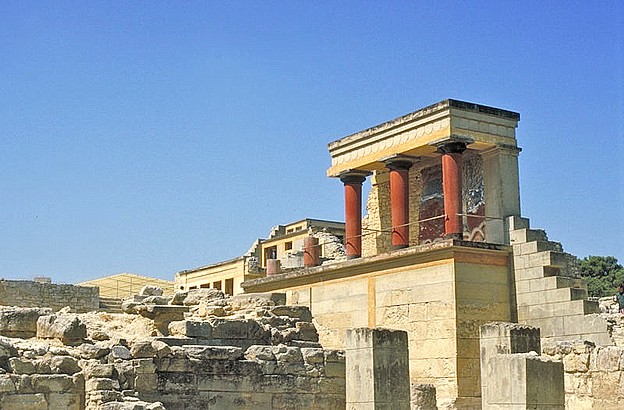
Palazzo di Minosse a Cnosso
Con il nome di Minosse si fa riferimento a un personaggio che, secondo la mitologia greca, era figlio di Zeus e di Europa. Minosse fu re giusto e saggio di Creta. Per questo motivo, dopo la sua morte, divenne uno dei giudici degli inferi, insieme a Eaco e Radamanto. Nei miti attici, invece, viene dipinto come estremamente crudele.
Il personaggio
Si racconta che in seguito alla morte del re Asterione, padre adottivo di Minosse, egli costruì un altare a Poseidone in riva al mare, per dimostrare il suo diritto alla successione al trono. Minosse pregò Poseidone di inviargli un toro per il sacrificio e il dio lo esaudì. Ma Minosse non sacrificò l'animale, poiché era molto bello. Poseidone, adirato, fece innamorare del toro Pasifae, la moglie di Minosse. Da questa unione nacque il Minotauro, mezzo uomo e mezzo toro. Minosse incaricò dunque Dedalo di costruire un labirinto in cui nascondere il mostro.
Minosse ebbe 8 figli: Catreo, Deucalione, Glauco, Androgeo, Acalla, Senodice, Arianna, Fedra. Il regno di Minosse fu caratterizzato da ampi scontri con i popoli vicini, che egli riuscì ad assoggettare. Combatté anche contro Niso, re di Megara, che aveva un capello d'oro a cui era legata la sorte della sua vita e della sua potenza. La figlia di Niso, Scilla, si innamorò al primo istante di Minosse e non indugiò a introdursi nottetempo nella camera del padre per tagliargli il capello d'oro. Andò in seguito da Minosse offrendogli le chiavi di Megara e chiedendogli di sposarla. Minosse conquistò Megara ma rifiutò di portare con sé a Creta la parricida che, presa dallo sconforto, si gettò in mare e annegò.
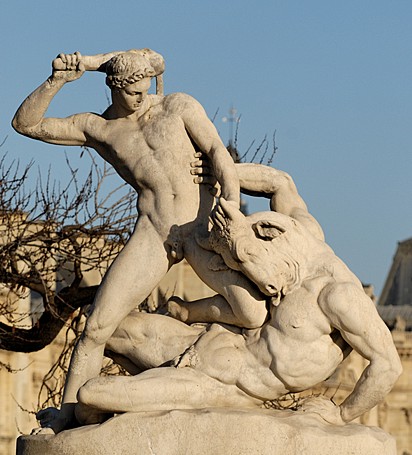
Thésée
et le Minotaure - 1826
par Étienne-Jules Ramey (1796-1852)
Jardins des Tuileries - Paris
Minosse attaccò anche Atene in seguito all'assassinio del figlio Androgeo causato dal re Egeo. Sconfitti gli ateniesi, Minosse chiese a essi in tributo la consegna annua di sette fanciulli e sette fanciulle, che venivano date in pasto al Minotauro. Tale sacrificio cessò solo in seguito all'intervento di Teseo, che aiutato da Arianna, riuscì a uccidere il Minotauro.
Storicità di Minosse
Così lo storico Tucidide descrive Minosse nelle sue Storie: « …Minosse infatti fu il più antico di quanti conosciamo per tradizione ad avere una flotta e dominare per la maggior estensione il mare ora greco, a signoreggiare sulle isole Cicladi e colonizzarne le terre dopo aver scacciato da esse i Cari ed avervi stabilito i suoi figli come signori. Eliminò per quanto poté la pirateria del mare, come è naturale, perché meglio gli giungessero i tributi… » (Tucidide, Storie I, IV)
« …Pirati erano soprattutto gli isolani, che erano Cari e Fenici..... ma al crearsi della flotta di Minosse, la navigazione tra un popolo e l'altro si sviluppò (i pirati furono da Minosse scacciati dalle isole, tutte le volte che lui ne colonizzava gran parte)… » (Tucidide, Storie I, VIII)
Minosse nell'Ade
Minosse, nell'interpretazione di Michelangelo Buonarroti, dal particolare del Giudizio Universale nella Cappella Sistina, rappresentato come giudice infernale.Già Omero lo aveva posto come giudice delle anime nell'Ade, ma Dante trasse la figura di Minosse da Virgilio:
«Queste dimore infernali non
sono state assegnate
senza giudizio e giudice: Minosse inquisitore
scuote l'urna dei fati, convoca l'assemblea
dei morti silenziosi, li interroga, ne apprende
i delitti e la vita »
(Virgilio Eneide, VI,539-543 Trad. C.Vivaldi)
Figura poi ripresa da Claudiano:
«L'Erebo mitiga
spontaneamente
la sua desolazione e concede che l'eterna notte si diradi
né l'urna di Minosse volge le incerte sorti »
(Claudio Claudiano De raptu
Proserpinae, II,330-332)
Minosse si trova all'entrata del Cerchio II perché le anime del Limbo (Cerchio I) non hanno peccati da confessare e non vengono giudicate. Nella mitologia dantesca, a Minosse è dato il compito di ascoltare i peccati delle anime, le quali nulla nascondono al demone. Uditi i peccati Minosse comunica loro la destinazione all'interno dell'inferno, arrotolando la coda di serpente di tante spire quanti sono i cerchi di destinazione.
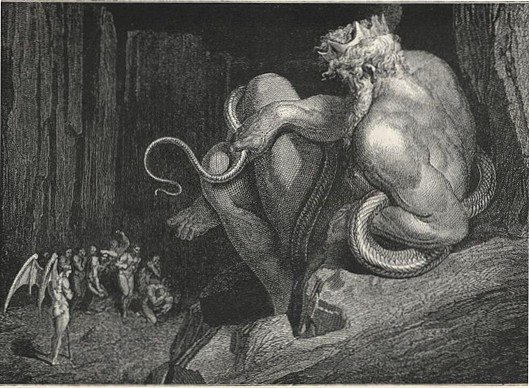
Minosse nell'Inferno di Dante
Gustave Paul Doré (Strasburgo 1832 - Parigi 1883)
« Stavvi Minòs
orribilmente, e ringhia:
essamina le colpe ne l'intrata;
giudica e manda secondo ch'avvinghia.
Dico che quando l'anima mal nata
li vien dinanzi, tutta si confessa;
e quel conoscitor de le peccata
vede qual loco d'inferno è da essa;
cignesi con la coda tante volte
quantunque gradi vuol che giù sia messa »
(Dante Alighieri Divina Commedia, Inferno,
V,4-12)
Monumento a Dante Alighieri - 1896
Trento – Piazza Dante
www.tripod.lycos.com
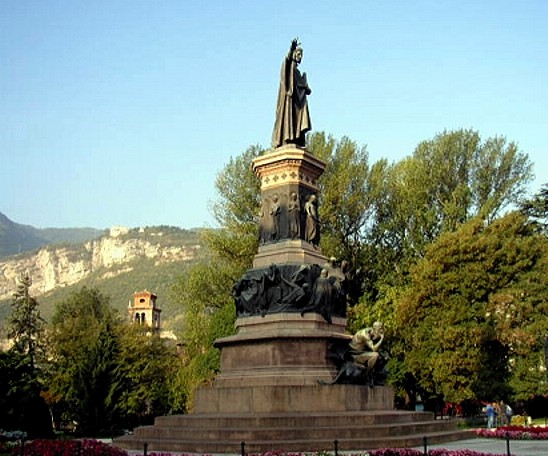
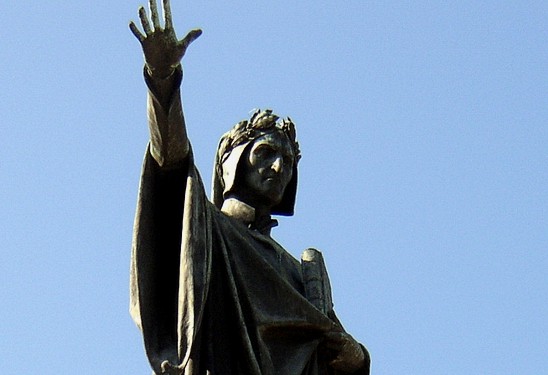
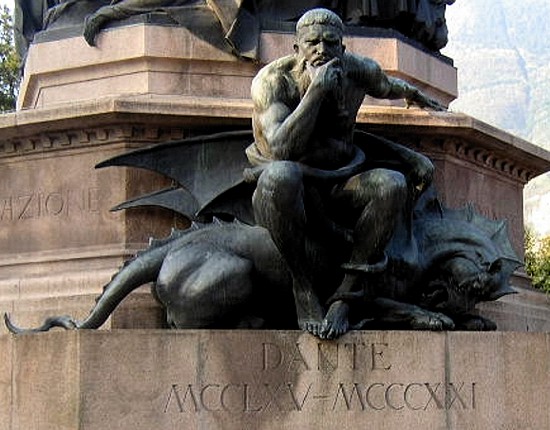
Minosse
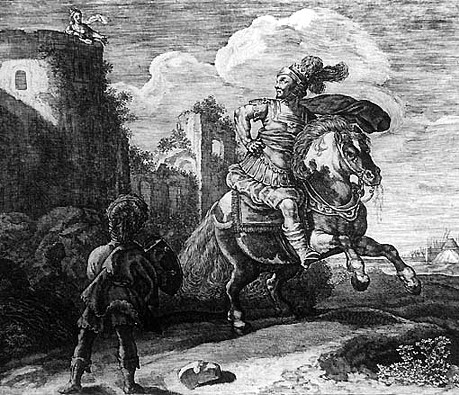
17th century engraving of Scylla falling in love with Minos
In Greek mythology, Minos (ancient Greek: Mínøs) was a mythical king of Crete, son of Zeus and Europa. After his death, Minos became a judge of the dead in Hades. The Minoan civilization has been named after him. By his wife, Pasiphaë, he fathered Ariadne, Androgeus, Deucalion, Phaedra, Glaucus, Catreus, Acacallis, and many others. Minos, along with his brothers, Rhadamanthys and Sarpedon, was raised by King Asterion (or Asterius) of Crete. When Asterion died, he gave his throne to Minos, who banished Sarpedon and (according to some sources) Rhadamanthys too.
It is not clear if Minos is a name or if it was the Cretan word for "King". Scholars have noted the interesting similarity between Minos and the names of other ancient founder-kings, such as Menes of Egypt, Mannus of Germany, Manu of India, and so on. There is a name in Linear A mi-nu-te that may be related to Minos. According to La Marle's reading of Linear A (see below), we should read mwi-nu ro-ja (Minos the king) on a Linear A tablet. The royal title ro-ja is read on several documents, including on stone libation tables from the sanctuaries, where it follows the name of the main god, Asirai (the equivalent of Sanskrit Asura, and of Avestan Ahura). The name mwi-nu (Minos) is expected to mean 'ascet' as Skr. muni, and this explanation fits the legend about Minos sometimes living in caves on Crete.
The literary Minos
Minos reigned over Crete and the islands of the Aegean Sea three generations before the Trojan War. He lived at Knossos for periods of nine years, where he received instruction from Zeus in the legislation which he gave to the island. This included the establishment of pederasty as a means of population control on the island community: They "segregated the women and instituted sexual relations among the males so that women would not have children." He was the author of the Cretan constitution and the founder of its naval supremacy. In Attic tradition and on the Athenian stage Minos is a cruel tyrant, the heartless exactor of the tribute of Athenian youths to feed the Minotaur. It seems possible that tribute children were actually exacted to take part in the gruesome shows of the Minoan bull-rings, of which we now have more than one illustration.
To reconcile the contradictory aspects of his character, as well as to explain how Minos governed Crete over a period spanning so many generations, two kings of the name of Minos were assumed by later poets and mythologists. According to this view, the first King Minos was the son of Zeus and Europa and brother of Rhadamanthys and Sarpedon. This was the 'good' king Minos, and he was held in such esteem by the Olympian gods that, after he died, he was made one of the three 'Judges of the Dead', alongside his brother Rhadamanthys and half-brother Aeacus. The wife of this Minos ('Minos I') was said to be Itone (daughter of Lyctius) or Crete (a nymph, or daughter of his stepfather Asterion), and he had a single son named Lycastus, his successor as King of Crete. Lycastus had a son named Minos, after his grandfather, born by Lycastus's wife, Ida, daughter of Corybas. This second Minos - the 'bad' king Minos - is the son of this Lycastus, and was a far more colorful character than his father and grandfather. It is to this Minos ('Minos II') that we owe the myths of Theseus, Pasiphaë, the Minotaur, Daedalus, Glaucus, and Nisus. Unlike Minos I, Minos II fathered numerous children, including Androgeus, Catreus, Deucalion, Ariadne, Phaedra, and Glaucus - all born to him by his wife Pasiphaë. He was the grandfather of King Idomeneus, who led the Cretans to the Trojan War.
Since relations with Phoenicia were in later times supposed to have played an important part in the development of Crete, Minos is sometimes called a Phoenician. There is no doubt that there is a considerable historical element in the legend; recent discoveries in Crete prove the existence of a civilization such as the legends imply, and render it possible that not only Athens, but Mycenae itself, was once subject to the kings of Knossos, of whom Minos was greatest, though this suggestion has been disputed and is no longer widely accepted. In view of the splendour and wide influence of Minoan Crete, the age generally known as "Mycenaean" has been given the name of "Minoan" by Dr. Arthur Evans, the chief proponent of a powerful Minoan empire, as more properly descriptive.
Minos himself is said to have died at Camicus in Sicily, whither he had gone
in pursuit of Daedalus, who had given Ariadne the clue by which she guided
Theseus through the labyrinth. He was killed by the daughter of Cocalus, king
of Agrigentum, who poured boiling water over him while he was taking a bath.
Subsequently his remains were sent back to the Cretans, who placed them in a
sarcophagus, on which was inscribed: "The tomb of Minos, the son of
Zeus."
The earlier legend knows Minos as a beneficent ruler, legislator, and
suppressor of piracy. His constitution was said to have formed the basis of
that of Lycurgus. In accordance with this, after his death he became judge of
the shades in the under-world. In later versions, Aeacus and Rhadamanthus were
made judges as well, with Minos leading as the "appeals court" judge.
Miletus
Asterios, king of Crete, adopted the three sons of Zeus and Europa, Minos, Sarpedon and Rhadamanthus. In adulthood, the three brothers quarreled over a beautiful boy they were all in love with, by the name of Miletus, son of Apollo and Areia. The youth however preferred Sarpedon, so Minos in revenge went to war and conquered the whole island. Sarpedon and Miletus escaped to Lycia, where Miletus founded the city that bore his name. Other mythographers claimed that the beloved youth's name was Atymnios, and that he was the son of Zeus and Cassiopeia.
Bernard Sergent claims that the story is a late invention in that the theme of competition for a beloved youth is not in keeping with the Cretan pederastic tradition, and there is no record of this Miletus prior to the second century BCE.
Glaucus
One day, Glaucus was playing with a ball or mouse and suddenly disappeared. His parents went to the oracle at Delphi who told them "A marvelous creature has been born amongst you: whoever finds the true likeness for this creature will also find the child." They interpreted this to refer to a newborn calf in Minos' herd. Three times a day, the calf changed color from white to red to black. Polyidus observed the similarity to the ripening of the fruit of the mulberry (or possibly the blackberry) plant and Minos sent him to find Glaucus.
Searching for the boy, Polyidus saw an owl driving bees away from a wine-cellar in Minos' palace. Inside the wine-cellar was a cask of honey, with Glaucus dead inside. Minos demanded Glaucus be brought back to life, though Polyidus objected. Minos was justified in his insistence, as the Delphic Oracle had said that the seer would restore the child alive. Minos shut Polyidus up in the wine-cellar with a sword. When a snake appeared nearby, Polyidus killed it with the sword. Another snake came for the first, and after seeing its mate dead, the second serpent left and brought back an herb which then brought the first snake back to life. Following this example, Polyidus used the same herb to resurrect Glaucus.
Minos refused to let Polyidus leave Crete until he taught Glaucus the art of divination. Polyidus did so, but then, at the last second before leaving, he asked Glaucus to spit in his mouth. Glaucus did so, and forgot everything he had been taught.
Poseidon, Daedalus and Pasiphaë
Minos was challenged as king and prayed to Poseidon for help. Poseidon sent a giant white bull out of the sea. Minos planned on sacrificing the bull to Poseidon, but then decided not to. He substituted a different bull. In rage, Poseidon cursed Pasiphaë, Minos' wife, with zoophilia. Daedalus built her a wooden cow, which she hid inside. The bull mated with the wooden cow and Pasiphaë was impregnated by the bull, giving birth to a horrible monster, the Minotaur (half man half bull). Daedalus then built a complicated maze called the Labyrinth and Minos put the Minotaur in it. To make sure no one would ever know the secret of who the Minotaur was and how to get out of the Labyrinth (Daedalus knew both of these things), Minos imprisoned Daedalus and his son, Icarus, along with the monster. Fortunately, both Daedalus and Icarus escaped the Labyrinth and the Minotaur's clutches, but they were marooned on Crete. Daedalus and Icarus flew away on wings Daedalus invented, but Icarus' wings melted because he flew too close to the sun. Icarus fell in the sea and drowned.
Theseus
Some time later, Minos' son, Androgeus, won every game in a contest to Aegeas of Athens. Alternatively, the other contestants were jealous of Androgeus and killed him. Minos was angry and declared war on Athens. He offered the Athenians peace if they sent Minos seven young men and seven virgin maidens to feed the Minotaur every nine years (which corresponded directly to the Minoans' meticulous records of lunar alignments - a full moon falls on the equinoxes once every eight years). This continued until Theseus killed the Minotaur with the help of Ariadne, Minos' lovestruck daughter. Athenaeus (c. AD 200), in his Deipnosophists, (XIII.601f), recounts a version of the tale in which the love of Minos for Theseus is the reason for his giving up his war against the Athenians.
Nisus
Minos was also part of the King Nisus story. Nisus was King of Megara, and he was invincible as long as a lock of purple hair still existed, hidden in his white hair. Minos attacked Megara but Nisus knew he could not be beaten because he still had his lock of purple hair. His daughter, Scylla, fell in love with Minos and proved it by cutting the purple hair off her father's head. Nisus died and Megara fell to Crete. Minos spurned Scylla for disobeying her father. She was changed into a seabird, relentlessly pursued by her father, who was a sea eagle.
The death of Minos
Minos searched for Daedalus by travelling from city to city asking a riddle. Minos presented a spiral seashell to Daedalus and asked for it to be strung all the way through. When he reached Camicus, Sicily's King Cocalus, knowing Daedalus would be able to solve the riddle, fetched the old man. He tied the string to an ant, which walked through the seashell, stringing it all the way through. Minos then knew Daedalus was in the court of King Cocalus and demanded he be handed over. Cocalus managed to convince him to take a bath first. Cocalus' daughters and Daedalus then killed Minos by burning him with boiling water. After his death, Minos became a judge of the dead in Hades together with Aeacus and Radamanthus. Radamanthus judged the souls of Asians, Aeacus judged Europeans and Minos had the deciding vote.
Minos in art
On Cretan coins, Minos is represented as bearded, wearing a diadem, curly-haired, haughty and dignified, like the traditional portraits of his reputed father, Zeus. On painted vases and sarcophagus bas-reliefs he frequently occurs with Aeacus and Rhadamanthus as judges of the under-world and in connection with the Minotaur and Theseus. In Michelangelo's famous fresco, The Last Judgment (located in the Sistine Chapel), Minos appears as judge of the under-world, surrounded by a crowd of devils. With a snake coiled around him, Minos watches as the damned are brought down to hell.
In poetry

Minos as portrayed in
Dante's Inferno
Gustave Paul Doré (Strasbourg 1832 - Paris 1883)
In the Aeneid of Virgil, Minos was the judge of those who had been given the death penalty on a false charge - Minos sits with a gigantic urn, and decides whether a soul should go to Elysium or Tartarus with the help of a silent jury. Radamanthus, his brother, is a judge at Tartarus who decides upon suitable punishments for sinners there.
In Dante's The Divine Comedy, Minos sits at the entrance to the second circle in the Inferno, which is the beginning of proper Hell. Here, he judges the sins of each soul and assigns it to its rightful punishment by indicating the circle to which it must descend. He does this by circling his tail around his body the appropriate number of times. He can also speak, to clarify the soul's location within the circle indicated by the wrapping of his tail.